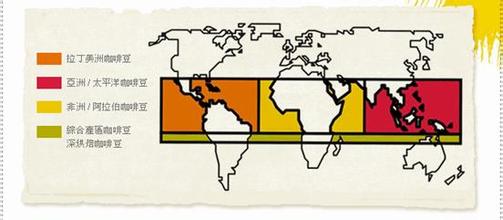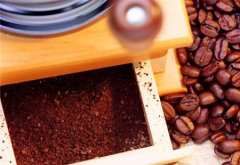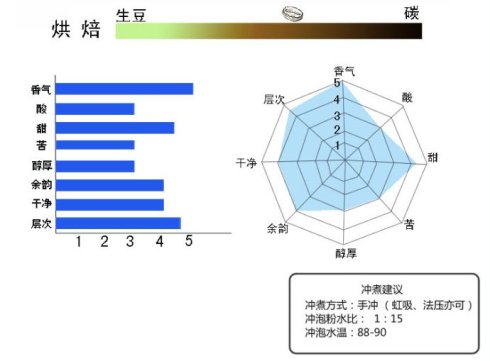Coffee Bean Varieties Arabica Bourbon Iron Pickup Arabica & Robasta Kenya
The well-known Arabica species (the main force of boutique coffee) and Robasta species (slightly rough flavor, more suitable for commercial use), Arabica was first identified in 1735 by the Swedish botanist Linnai, more than 100 years earlier than Robasta.
There are two to three thousand varieties under Arabica, all of which are constantly mutated and derived from the oldest iron pickup (Typica) in Ethiopia (the birthplace of coffee) and Bourbon in Yemen after they were transplanted to Central and South America or Asia. The following are the main varieties under Arabica:
Ancient native species
1. Typica: the oldest native variety of Ethiopia (birthplace of coffee), with elegant flavor, weak physique, poor disease resistance and low yield. the well-known Mantenin in Indonesia, Blue Mountain in Jamaica, elephant beans in Cuba, Hawaii Kona, Yunnan small grains, geisha, etc., are all derived varieties of Ironpickup, which are large, pointed oval or thin.
two。 Bourbon: an ancient and excellent variety juxtaposed with iron pickup, it is an early variety of iron pickup. In 1715, France began to pay attention to the transplantation of Yemeni mocha round beans to Bourbon Island on the east coast of Africa, which is obviously different from tin tin card beans. Bourbon is mainly round beans (except the tip of bourbon variety).
Gene mutant
1. Kenya SL28, SL34 (bourbon direct line): French and British missionaries and researchers screened and cultivated bourbon direct line in Kenya at the beginning of the 20th century. The special high concentration phosphoric acid soil gave birth to special sour flavor. The top Kenyan beans are all from these two varieties, which will definitely lose their taste when transplanted to other major continents.
two。 Geisha (Geisha): a species that has become popular in recent years, belonging to the Ironka family, it was obscure transplanted from the Geisha Mountains in southwestern Ethiopia to Kenya, Tanzania and Costa Rica in 1913 and to Panama in the 1960s. It took about half a century to become a blockbuster, defeating the victorious generals such as Bourbon, Kaddura, Kaduai and the Iron pickup, and sold at a high price of $130 per pound in 2007. It ranks in the first few years of the list of high-priced high-quality beans.
3. Yellow bourbon (Bourbon Amarello): the general coffee fruit is red when ripe, but the yellow bourbon is yellow when it is ripe. It is a yellow bourbon variety peculiar to the state of Sao Paulo, Brazil. In the past two years, the Brazilian extraordinary Cup was almost won by Yellow bourbon.
4. Kaddura (Caturra): a single gene variant of bourbon was found in Brazil in the 1950s. Its production capacity and disease resistance are stronger than bourbon, and its flavor is comparable. It is suitable for planting at 700m-1700 m, and it has strong adaptability to altitude, but the yield of planting at high altitude will be relatively reduced.
5. Pacas: a bourbon variant was found in El Salvador. In 1935, Salvadoran coffee farmers implanted the selected San Ramon bourbon into the manor. In 1956, friends of Parkas found that a few coffee trees had a higher result than most coffee trees, so they invited Gwell, a professor at the University of Florida, to identify it as a bourbon gene mutation and named it after coffee farmer Pacas, who had high yield and good quality. It's very popular in Central America.
6. Vera Saatchi (Villa Sarchi): the bourbon variety found in Costa Rica in the 1960s has appeared on the list of winners in recent years.
7. Like beans (Maragogype): the size of beans is at least three times larger than that of Arabica, and it is the largest coffee bean in the world. It is a variety of iron pickups. In 1870, it was first found in the Malago Gippe producing area in northeastern Brazil. It is suitable for growing in the range of 700-800m above sea level, but the flavor is not distinctive, even with a fishy smell.
Arabica intraspecific hybridization
1. New World (Mundo Novo): a natural hybrid of Bourbon and Sumatra iron pickup, first found in Brazil, is regarded as the new hope of the Brazilian coffee industry, so it is named the New World species.
two。 Catuai: it is a hybrid of New World and Kaddura. It produces solid fruit and is not afraid to blow down in the event of a strong wind, which makes up for the weakness of Arabica fruit. Red fruit Kaduai often wins awards and ranks with Yellow bourbon, New World and Red bourbon as the four main varieties of Brazilian coffee.
3. Pacamara (Pacamara): the pedigree is more complex. It was produced by the Salvadoran Coffee Research Association from 1957 to 1958. It is a hybrid of a variety of iron pickup like beans and a variety of bourbon. In the past two years, it is also a hybrid of high-quality coffee all over the world. It once won the double-material championship of Guatemala and Honduras in 2007.
4. Kent: a hybrid breed of iron pickup found in India.
Arabica crosses with Robasta
1. Timor: a hybrid of Arabica, Baba and Robasta found in East Timor.
two。 Catimor: currently the main variety of commercial beans, East Timor was colonized by Portugal for 400 years, in 1959 the Portuguese transplanted the Brazilian bourbon variety Kaddura to East Timor and Timo mixed race, from 1970 to 1990, coffee leaf rust affected the global coffee producing areas, only Katimo did not suffer from the disease, although strong disease resistance, but also inherited the lack of Robasta flavor.
3. Icatu: a masterpiece of many generations of Brazilian hybrid and improved varieties, this variety has repeatedly entered the top 10 of the Brazilian Chaofan Cup, and the latter potential is good.
4. Ruiru (Ruiru 11): a hybrid variety with high yield and low quality. In 1985, the hybrid between Timo and Robasta by the Ruiru Coffee Research Center in Kenya had high yield but poor flavor and could not be planted on a large scale.
5. Qiangzhuogili (Chandragiri): in December 2007, the latest mixed-race variety cultivated and mass-produced in India has a high yield, but its flavor has to be tested by the market.

Important Notice :
前街咖啡 FrontStreet Coffee has moved to new addredd:
FrontStreet Coffee Address: 315,Donghua East Road,GuangZhou
Tel:020 38364473
- Prev

What should I pay attention to in coffee grinding? What are the techniques for grinding coffee beans? How to study coffee beans
The ideal time to grind coffee is to grind it before steaming. Because ground coffee is easy to oxidize and lose its flavor, especially without proper storage, coffee powder is also easy to change flavor, so it is naturally impossible to brew mellow coffee. Some people are afraid of trouble or do not want to buy a bean grinder. They usually buy ready-made coffee powder when drinking coffee at home. At this time, they should pay special attention to storage.
- Next

How to choose coffee beans? how to buy coffee beans?
No matter what kind of coffee beans, freshness is an important factor affecting the quality. When choosing and buying, grab one or two coffee beans and chew them in your mouth. If there is a clear sound (indicating that the coffee beans are not damp) and the tooth pods stay fragrant, it is the top grade. No matter what kind of coffee beans, freshness is an important factor affecting the quality of coffee. When shopping, grab one or two coffee beans and chew them in your mouth, if they are crisp.
Related
- Guji coffee producing area of Guji, Ethiopia: Humbela, Shakiso, Wulaga
- What is the most expensive variety of Qiloso in BOP multi-variety group?
- How to store the coffee beans bought home?
- Why are Yemeni coffee beans so rare now?
- Ethiopian Sidamo all Red Fruit Sun Sun Santa Vini Coffee beans
- SOE is mostly sour? What does it mean? Is it a single bean? what's the difference between it and Italian blending?
- Is Italian coffee beans suitable for making hand-brewed coffee?
- How to choose coffee beans when making cold coffee? What kind of coffee beans are suitable for making cold coffee?
- Just entered the pit to make coffee, what kind of coffee beans should be chosen?
- Can only Japan buy real Blue Mountain Coffee? What are authentic Jamaican Blue Mountain coffee beans?

